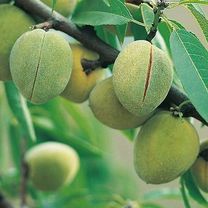How to Grow Almonds – A Guide to Growing Almonds
 Almond trees are In the same family as peaches, nectarines and plums, and the nuts grow as kernels within the fruit in the same way. Almonds can be grown from the nut (or seed) but it is more reliable to buy a young tree, either bare root or pot grown, which will fruit in its second or third year.
Almond trees are In the same family as peaches, nectarines and plums, and the nuts grow as kernels within the fruit in the same way. Almonds can be grown from the nut (or seed) but it is more reliable to buy a young tree, either bare root or pot grown, which will fruit in its second or third year.
Almonds are easy to grow but cropping will be light unless the right weather conditions prevail: warm, dry summers and frost-free winters. They have good drought resistance once established.
Growing Almonds
- Pot grown almond trees can be planted at any time of year, but it is best to plant during the dormant period in winter as long as the soil is not frozen or water-logged; bare rooted trees should be planted late autumn–early spring.
- Almonds are happiest in free draining, deep soil.
- They prefer a sunny position but will tolerate light shade. The nuts will not ripen in shaded areas.
- Always plant your fruit tree so that the grafting union is above the level of the soil.
- Dig a hole large enough to comfortably accommodate the depth and size of the roots and water in well after planting.
- Remove any vegetation around the base of the tree and mulch well, to help keep in the moisture and discourage weeds, etc, growing and competing with the young tree.
- The tree will flower on second year wood – prune after the tree has flowered and set fruit.
Harvesting Almonds
- Harvest Almonds late August–September.
- In a warm, dry summer, the fleshy outer hulls or casings will begin to split open, allowing the kernel to dry. If the weather is not co-operative, you will need to cut the outer casing to remove the kernel. Ideally, the almonds will be ready to harvest when three-quarters or so of the hulls are split open.
- Pick the almonds or shake out them out of the tree, laying a net or sheet underneath to catch them. A broom handle is a useful aid to knocking the nuts off the tree.
- Lay out the kernels in a warm place with good air circulation to dry for a few days.
- Almonds can be stored in their kernel, or shelled.
Pests and Problems with Almonds
- Almond trees can suffer peach leaf curl. Read advice on dealing with peach leaf curl, or grow a resistant variety.
Varieties of Almond
- Make sure that you buy a sweet almond tree, not a bitter almond variety grown for its flowers.
- Almond tree Robijn is self-fertile and has good resistance to peach leaf curl.
Eating
- In some varieties the fruit flesh is edible in the same way as peaches and nectarines.
- Almonds can be used in many different ways.



